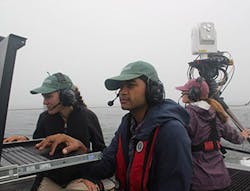Johns Hopkins team demonstrates high-bandwidth free-space optical communications at sea
Engineers from the Johns Hopkins University Applied Physics Laboratory (APL; Laurel, MD) have demonstrated a high-bandwidth free-space optical (FSO) communications system between two moving ships, proving operational utility of FSO technology in the maritime environment.
Juan Juarez, the technical lead for the team developing the technology, said APL is the first organization to successfully operate such a high-capacity optical communications capability—up to 10 Gbit/s—on the move, on board ships at sea, and in challenging near-shore environments.
"We demonstrated bandwidths that were several orders of magnitude higher than all current radio-frequency [RF] communications capability on Navy vessels, and at longer ranges than previously demonstrated FSO technology for maritime applications," Juarez says. "This is the equivalent to having up to 2000 users simultaneously watching high-definition video streams across the optical link."
The Lab demonstrated its latest compact-form-factor system at the 2017 Trident Warrior Exercise, an annual event where sailors try out the newest innovations in naval warfare systems and provide feedback on those systems to commanders and developers.
Navy needs higher rates than RF
Navy ships typically use RF systems to communicate, but the Navy also looks for alternative means of communication in case, for technical, operational or environmental reasons, radio transmission isn't available. "Naval platforms increasingly need to operate effectively in reduced-RF or emission control conditions while maintaining their tactical advantage and situational awareness," notes Juarez.
Commercial FSO systems exist but typically don't address defense needs, Juarez says, "specifically in terms of system mobility, link range, and data rate while operating in the highly scintillated terrestrial environment, especially close to the water." FSO demonstration systems previously built for terrestrial defense applications have been too large, or lacked the mobility, data rates, or ranges to be practical on naval platforms.
APL's adaptive-optical system overcomes many of these challenges. The first week of testing was ship-to-shore, from the motor vessel (M/V) Merlin off the coast of Naval Base Point Loma, San Diego, to the 3rd Fleet Headquarters parking lot. The team achieved more than 14 hours of link-up time, including during 4- to 6-foot high seas; 1-2 Gbit of error-free data transport at ranges greater than 25 km; voice communications at greater than 35 km; chat messaging out to 45 km, the maximum available line of sight; and repeatable, semiautomatic reacquisitions over the entire line-of-sight range.
"Weather conditions during the two weeks of testing were typical of San Diego's 'June Gloom' and gave the APL team plenty of opportunities to show that our FSO technology can operate even through some levels of fog and haze," Juarez says. "While the fog layer was present, links of over 10 km were achieved, even though visibility at times was reduced to 2-3 km."
During the second week of testing, the second set of hardware was installed onboard the Sea Hunter, an autonomous continuous trail unmanned vessel (ACTUV) developed by the Defense Advanced Research Projects Agency (DARPA) and the Office of Naval Research. The Sea Hunter was temporarily manned by a six-person Space and Naval Warfare Command crew in addition to the APL test team for this demonstration.
Links at varying rates up to 7.5 Gbit/s
Multiple links between the two ships were achieved in 3- to 5-foot swells, over 10 km in range, with ACTUV Sea Hunter going 24 knots and M/V Merlin going 12 knots in a "V" formation that allowed the ships to quickly separate from one another, while maintaining the links at varying speeds and motions.
"Despite seas that had both ships rolling with the swells, the link stayed solid," Juarez says. The FSO equipment experienced significant sea spray, and the omnipresent San Diego marine layer fog added an additional challenge to the ship-to-ship linkages. Nonetheless, first-time data rates as high as 7.5 Gbit were achieved over a link between two vessels.
"The demonstrated performance of APL's laser communications systems opens up various potential applications," says APL's Air and Missile Defense Sector Head Mike White. "We are looking forward to working with sponsors and warfighters to further develop this game-changing technology."
Source: http://www.jhuapl.edu/newscenter/pressreleases/2017/170824b.asp
About the Author
John Wallace
Senior Technical Editor (1998-2022)
John Wallace was with Laser Focus World for nearly 25 years, retiring in late June 2022. He obtained a bachelor's degree in mechanical engineering and physics at Rutgers University and a master's in optical engineering at the University of Rochester. Before becoming an editor, John worked as an engineer at RCA, Exxon, Eastman Kodak, and GCA Corporation.

